
Am Fam Physician. 2016;93(8):online
Related Editorial: Counseling Women About Breast Cancer Screening.
Related Practice Guideline: ACS Releases Guideline on Breast Cancer Screening.
Summary of Recommendations and Evidence
The USPSTF recommends biennial screening mammography for women aged 50 to 74 years (Table 1). B recommendation.
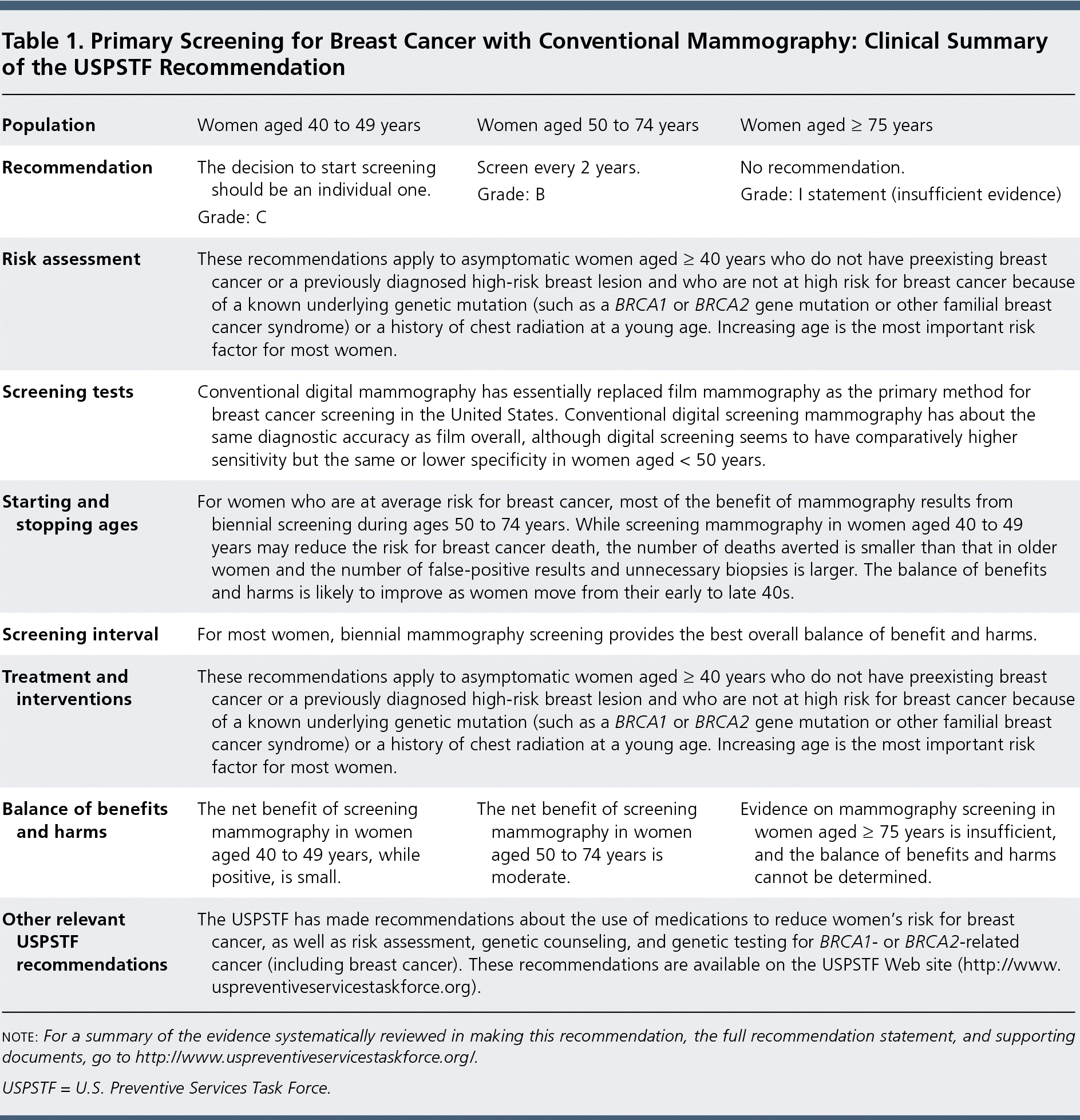
| Population | Women aged 40 to 49 years | Women aged 50 to 74 years | Women aged ≥ 75 years |
| Recommendation | The decision to start screening should be an individual one. | Screen every 2 years. | No recommendation. |
| Grade: C | Grade: B | Grade: I statement (insufficient evidence) | |
| Risk assessment | These recommendations apply to asymptomatic women aged ≥ 40 years who do not have preexisting breast cancer or a previously diagnosed high-risk breast lesion and who are not at high risk for breast cancer because of a known underlying genetic mutation (such as a BRCA1 or BRCA2 gene mutation or other familial breast cancer syndrome) or a history of chest radiation at a young age. Increasing age is the most important risk factor for most women. | ||
| Screening tests | Conventional digital mammography has essentially replaced film mammography as the primary method for breast cancer screening in the United States. Conventional digital screening mammography has about the same diagnostic accuracy as film overall, although digital screening seems to have comparatively higher sensitivity but the same or lower specificity in women aged < 50 years. | ||
| Starting and stopping ages | For women who are at average risk for breast cancer, most of the benefit of mammography results from biennial screening during ages 50 to 74 years. While screening mammography in women aged 40 to 49 years may reduce the risk for breast cancer death, the number of deaths averted is smaller than that in older women and the number of false-positive results and unnecessary biopsies is larger. The balance of benefits and harms is likely to improve as women move from their early to late 40s. | ||
| Screening interval | For most women, biennial mammography screening provides the best overall balance of benefit and harms. | ||
| Treatment and interventions | These recommendations apply to asymptomatic women aged ≥ 40 years who do not have preexisting breast cancer or a previously diagnosed high-risk breast lesion and who are not at high risk for breast cancer because of a known underlying genetic mutation (such as a BRCA1 or BRCA2 gene mutation or other familial breast cancer syndrome) or a history of chest radiation at a young age. Increasing age is the most important risk factor for most women. | ||
| Balance of benefits and harms | The net benefit of screening mammography in women aged 40 to 49 years, while positive, is small. | The net benefit of screening mammography in women aged 50 to 74 years is moderate. | Evidence on mammography screening in women aged ≥ 75 years is insufficient, and the balance of benefits and harms cannot be determined. |
| Other relevant USPSTF recommendations | The USPSTF has made recommendations about the use of medications to reduce women's risk for breast cancer, as well as risk assessment, genetic counseling, and genetic testing for BRCA1- or BRCA2-related cancer (including breast cancer). These recommendations are available on the USPSTF Web site (http://www.uspreventiveservicestaskforce.org). | ||
The decision to start screening mammography in women prior to age 50 years should be an individual one. Women who place a higher value on the potential benefit than the potential harms may choose to begin biennial screening between the ages of 40 and 49 years. C recommendation.
For women who are at average risk for breast cancer, most of the benefit of mammography results from biennial screening during ages 50 to 74 years. Of all of the age groups, women aged 60 to 69 years are most likely to avoid breast cancer death through mammography screening. While screening mammography in women aged 40 to 49 years may reduce the risk for breast cancer death, the number of deaths averted is smaller than that in older women and the number of false-positive results and unnecessary biopsies is larger. The balance of benefits and harms is likely to improve as women move from their early to late 40s.
In addition to false-positive results and unnecessary biopsies, all women undergoing regular screening mammography are at risk for the diagnosis and treatment of noninvasive and invasive breast cancer that would otherwise not have become a threat to their health, or even apparent, during their lifetime (“overdiagnosis”). Beginning mammography screening at a younger age and screening more frequently may increase the risk for overdiagnosis and subsequent overtreatment.
Women with a parent, sibling, or child with breast cancer are at higher risk for breast cancer and thus may benefit more than average-risk women from beginning screening in their 40s.
Go to the Clinical Considerations section for information on implementation of the C recommendation.
The USPSTF concludes that the current evidence is insufficient to assess the balance of benefits and harms of screening mammography in women aged 75 years or older. I statement.
The USPSTF concludes that the current evidence is insufficient to assess the benefits and harms of digital breast tomosynthesis (DBT) as a primary screening method for breast cancer (Table 2). I statement.
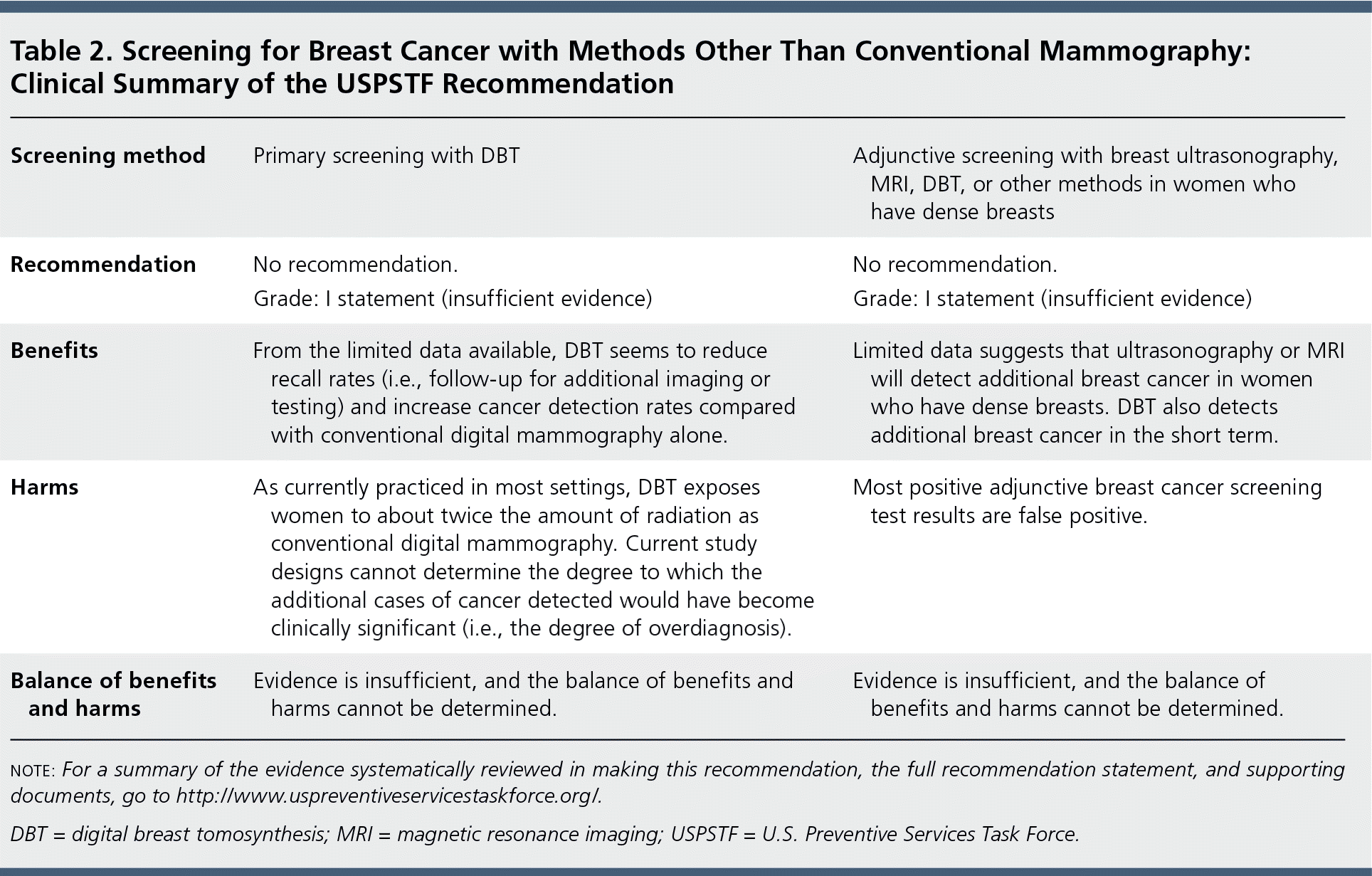
| Screening method | Primary screening with DBT | Adjunctive screening with breast ultrasonography, MRI, DBT, or other methods in women who have dense breasts |
| Recommendation | No recommendation. | No recommendation. |
| Grade: I statement (insufficient evidence) | Grade: I statement (insufficient evidence) | |
| Benefits | From the limited data available, DBT seems to reduce recall rates (i.e., follow-up for additional imaging or testing) and increase cancer detection rates compared with conventional digital mammography alone. | Limited data suggests that ultrasonography or MRI will detect additional breast cancer in women who have dense breasts. DBT also detects additional breast cancer in the short term. |
| Harms | As currently practiced in most settings, DBT exposes women to about twice the amount of radiation as conventional digital mammography. Current study designs cannot determine the degree to which the additional cases of cancer detected would have become clinically significant (i.e., the degree of overdiagnosis). | Most positive adjunctive breast cancer screening test results are false positive. |
| Balance of benefits and harms | Evidence is insufficient, and the balance of benefits and harms cannot be determined. | Evidence is insufficient, and the balance of benefits and harms cannot be determined. |
The USPSTF concludes that the current evidence is insufficient to assess the balance of benefits and harms of adjunctive screening for breast cancer using breast ultrasonography, magnetic resonance imaging (MRI), DBT, or other methods in women identified to have dense breasts on an otherwise negative screening mammogram. I statement.
These recommendations apply to asymptomatic women aged 40 years or older who do not have preexisting breast cancer or a previously diagnosed high-risk breast lesion and who are not at high risk for breast cancer because of a known underlying genetic mutation (such as a BRCA1 or BRCA2 gene mutation or other familial breast cancer syndrome) or a history of chest radiation at a young age.
Rationale
IMPORTANCE
Breast cancer is the second-leading cause of cancer death among women in the United States. In 2015, an estimated 232,000 women were diagnosed with the disease and 40,000 women died of it. It is most frequently diagnosed among women aged 55 to 64 years, and the median age of death from breast cancer is 68 years.1
BENEFIT AND HARMS OF SCREENING AND EARLY TREATMENT
The USPSTF found adequate evidence that mammography screening reduces breast cancer mortality in women aged 40 to 74 years. The number of breast cancer deaths averted increases with age; women aged 40 to 49 years benefit the least and women aged 60 to 69 years benefit the most. Age is the most important risk factor for breast cancer, and the increased benefit observed with age is at least partly due to the increase in risk. Women aged 40 to 49 years who have a first-degree relative with breast cancer have a risk for breast cancer similar to that of women aged 50 to 59 years without a family history. Direct evidence about the benefits of screening mammography in women aged 75 years or older is lacking.
The USPSTF found adequate evidence that screening for breast cancer with mammography results in harms for women aged 40 to 74 years. The most important harm is the diagnosis and treatment of noninvasive and invasive breast cancer that would otherwise not have become a threat to a woman's health, or even apparent, during her lifetime (that is, overdiagnosis and overtreatment). False-positive results are common and lead to unnecessary and sometimes invasive follow-up testing, with the potential for psychological harms (such as anxiety). False-negative results (that is, missed cancer) also occur and may provide false reassurance. Radiation-induced breast cancer and resulting death can also occur, although the number of both of these events is predicted to be low.
The USPSTF found inadequate evidence on the benefits and harms of DBT as a primary screening method for breast cancer. Similarly, the USPSTF found inadequate evidence on the benefits and harms of adjunctive screening for breast cancer using breast ultrasonography, MRI, DBT, or other methods in women identified to have dense breasts on an otherwise negative screening mammogram. In both cases, while there is some information about the accuracy of these methods, there is no information on the effects of their use on health outcomes, such as breast cancer incidence, mortality, or overdiagnosis rates.
USPSTF ASSESSMENT
The USPSTF concludes with moderate certainty that the net benefit of screening mammography in women aged 50 to 74 years is moderate.
The USPSTF concludes with moderate certainty that the net benefit of screening mammography in the general population of women aged 40 to 49 years, while positive, is small.
The USPSTF concludes that the evidence on mammography screening in women aged 75 years and older is insufficient, and the balance of benefits and harms cannot be determined.
The USPSTF concludes that the evidence on DBT as a primary screening modality for breast cancer is insufficient, and the balance of benefits and harms cannot be determined.
The USPSTF concludes that the evidence on adjunctive screening for breast cancer using breast ultrasound, MRI, DBT, or other methods in women identified to have dense breasts on an otherwise negative screening mammogram is insufficient, and the balance of benefits and harms cannot be determined.
Clinical Considerations
BENEFIT OF SCREENING
The results of the meta-analysis of clinical trials from the systematic evidence review commissioned by the USPSTF are summarized in Table 3. Over a 10-year period, screening 10,000 women aged 60 to 69 years will result in 21 (95% CI, 11 to 32) fewer breast cancer deaths. The benefit is smaller in younger women: Screening 10,000 women aged 50 to 59 years will result in 8 (CI, 2 to 17) fewer breast cancer deaths, and screening 10,000 women aged 40 to 49 years will result in 3 (CI, 0 to 9) fewer breast cancer deaths.2,3 Most of these trials began enrollment more than 30 years ago, and these estimates may not reflect the current likelihood of avoiding a breast cancer death with contemporary screening mammography technology. Mammography imaging has since improved, which may result in more tumors being detected at a curable stage today than at the time of these trials. However, breast cancer treatments have also improved, and as treatment improves, the advantage of earlier detection decreases, so that some of the women who died of breast cancer in the nonscreened groups in these trials would survive today.
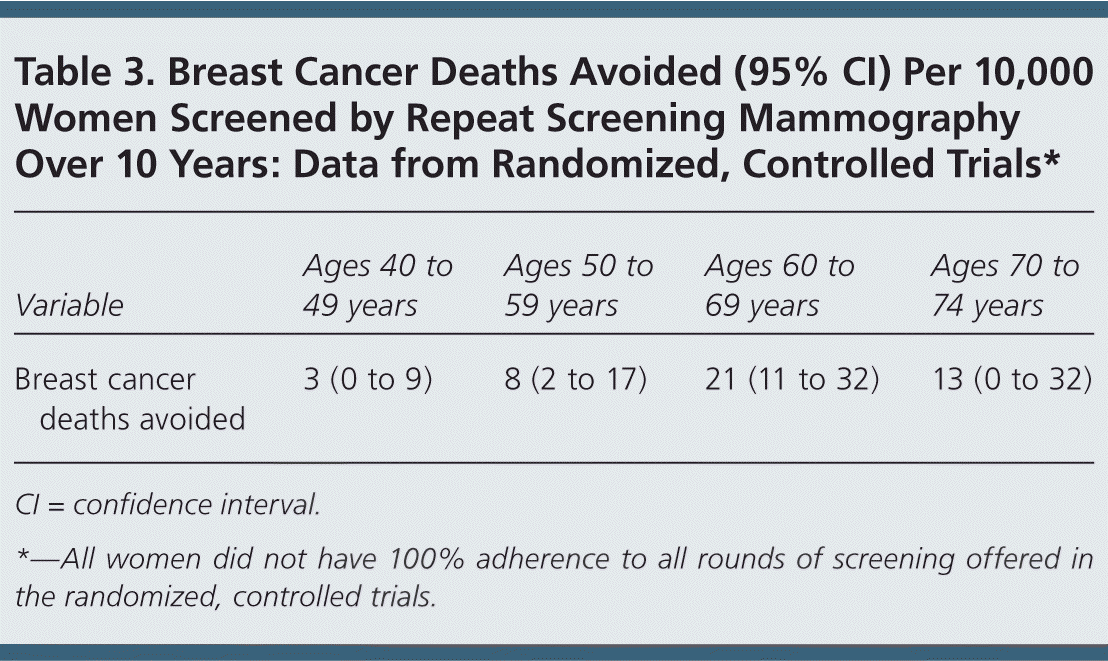
| Variable | Ages 40 to 49 years | Ages 50 to 59 years | Ages 60 to 69 years | Ages 70 to 74 years |
|---|---|---|---|---|
| Breast cancer deaths avoided | 3 (0 to 9) | 8 (2 to 17) | 21 (11 to 32) | 13 (0 to 32) |
HARMS OF SCREENING
The most important harm of screening is the detection and treatment of invasive and noninvasive cancer that would never have been detected, or threaten health, in the absence of screening (overdiagnosis and overtreatment). Existing science does not allow for the ability to determine precisely what proportion of cancer diagnosed by mammography today reflects overdiagnosis, and estimates vary widely depending on the data source and method of calculation used.2,4 In the United States, the rate of diagnosis of invasive plus noninvasive breast cancer increased by 50% during the era of mammography screening (http://www.uspreventiveservicestaskforce.org/Page/Document/RecommendationStatementFinal/breast-cancer-screening1#fig).5 It is not possible to know with certainty what proportion of that increase is due to overdiagnosis and what proportion reflects other reasons for a rising incidence. If overdiagnosis is the only explanation for the increase, 1 in 3 women diagnosed with breast cancer today is being treated for cancer that would never have been discovered or caused her health problems in the absence of screening. The best estimates from randomized, controlled trials evaluating the effect of mammography screening on breast cancer mortality suggest that 1 in 5 women diagnosed with breast cancer over approximately 10 years will be overdiagnosed.6 Modeling studies conducted in support of this recommendation by the Cancer Intervention and Surveillance Modeling Network (CISNET) provide a range of estimates that reflect different underlying assumptions; the median estimate is that 1 in 8 women diagnosed with breast cancer with biennial screening from ages 50 to 74 years will be overdiagnosed. The rate increases with an earlier start age or with annual mammography.7,8 Even with the conservative estimate of 1 in 8 breast cancer cases being overdiagnosed, for every woman who avoids a death from breast cancer through screening, 2 to 3 women will be treated unnecessarily.
The other principal harms of screening are false-positive results, which require further imaging and often breast biopsy, and false-negative results. Table 4summarizes the rates of these harms per screening round using registry data for digital mammography from the Breast Cancer Surveillance Consortium (BCSC), a collaborative network of 5 mammography registries and 2 affiliated sites with linkages to tumor registries across the United States.2,9 (Note that Table 4 describes a different time horizon than Table 3 [per screening round rather than per decade].)
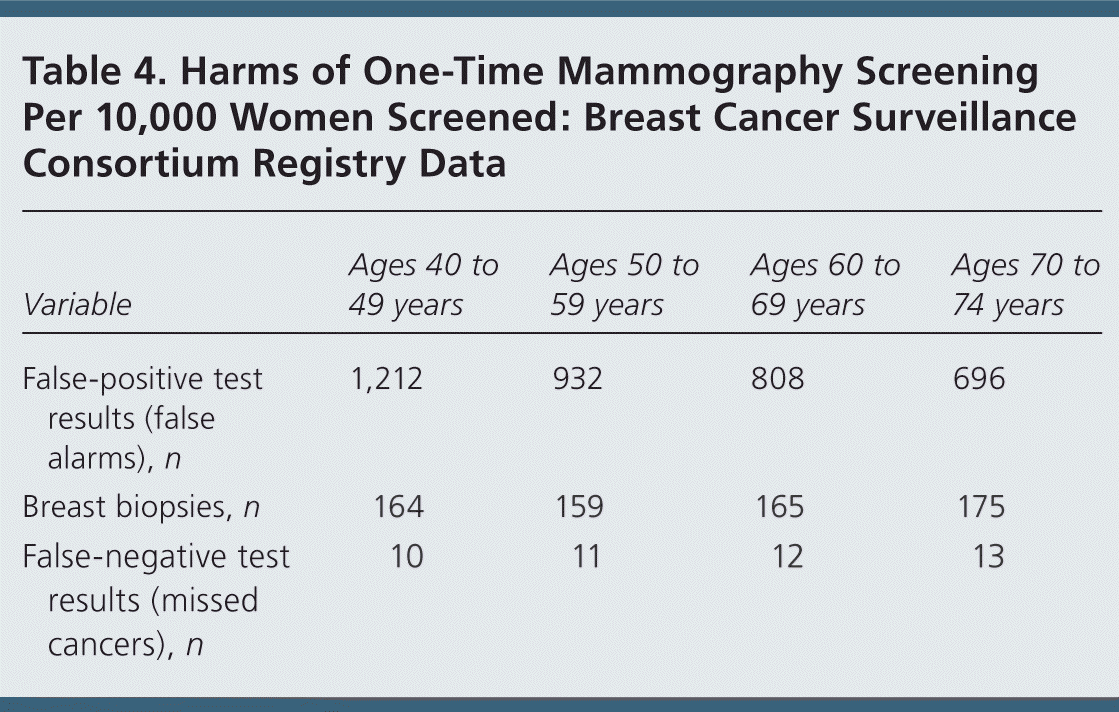
| Variable | Ages 40 to 49 years | Ages 50 to 59 years | Ages 60 to 69 years | Ages 70 to 74 years |
|---|---|---|---|---|
| False-positive test results (false alarms), n | 1,212 | 932 | 808 | 696 |
| Breast biopsies, n | 164 | 159 | 165 | 175 |
| False-negative test results (missed cancers), n | 10 | 11 | 12 | 13 |
WHEN TO START SCREENING
Clinical trials, observational studies, and modeling studies all demonstrate that the likelihood of avoiding a breast cancer death with regular screening mammography increases with age, and this increase in benefit likely occurs gradually rather than abruptly at any particular age. In contrast, the harms of screening mammography either remain constant or decrease with age. For example, about the same number of breast biopsies are performed as a result of screening mammography in women aged 40 to 49 years as in those aged 60 to 69 years, but many more of these biopsies will result in a diagnosis of invasive cancer in the older age group. Thus, the balance of benefit and harms improves with age (Table 5).
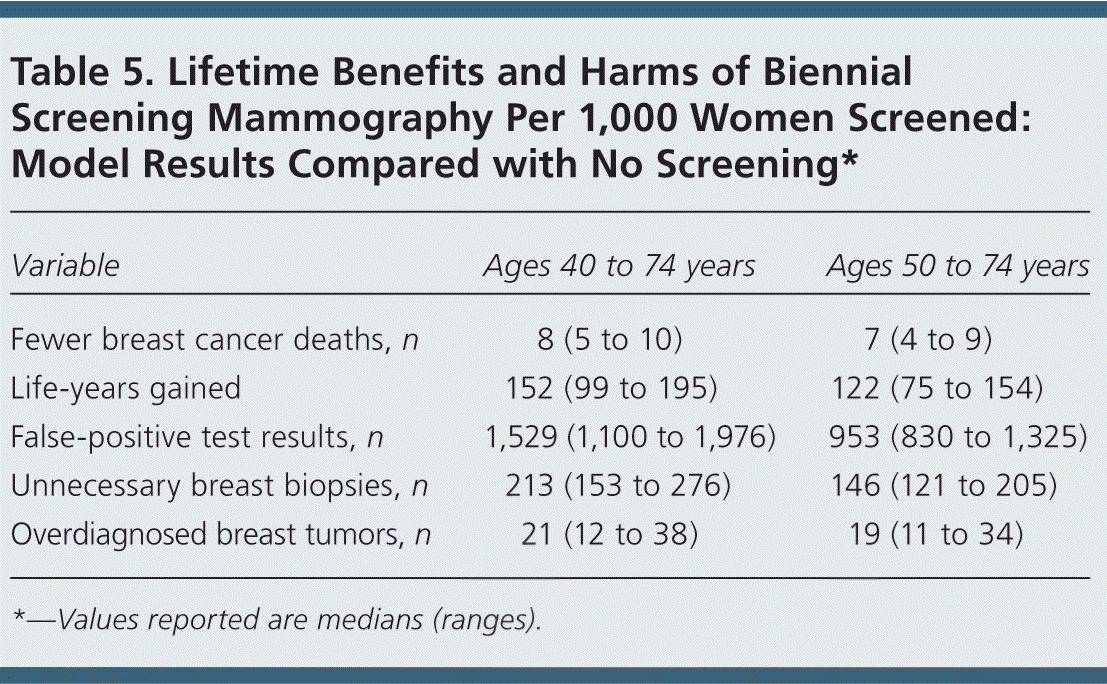
| Variable | Ages 40 to 74 years | Ages 50 to 74 years |
|---|---|---|
| Fewer breast cancer deaths, n | 8 (5 to 10) | 7 (4 to 9) |
| Life-years gained | 152 (99 to 195) | 122 (75 to 154) |
| False-positive test results, n | 1,529 (1,100 to 1,976) | 953 (830 to 1,325) |
| Unnecessary breast biopsies, n | 213 (153 to 276) | 146 (121 to 205) |
| Overdiagnosed breast tumors, n | 21 (12 to 38) | 19 (11 to 34) |
The USPSTF concludes that while there are harms of mammography, the benefit of screening mammography outweighs the harms by at least a moderate amount from age 50 to 74 years and is greatest for women in their 60s. For women in their 40s, the number who benefit from starting regular screening mammography is smaller and the number experiencing harm is larger compared with older women. For women in their 40s, the benefit still outweighs the harms, but to a smaller degree; this balance may therefore be more subject to individual values and preferences than it is in older women. Women in their 40s must weigh a very important but infrequent benefit (reduction in breast cancer deaths) against a group of meaningful and more common harms (overdiagnosis and overtreatment, unnecessary and sometimes invasive follow-up testing and psychological harms associated with false-positive test results, and false reassurance from false-negative test results). Women who value the possible benefit of screening mammography more than they value avoiding its harms can make an informed decision to begin screening.
Neither clinical trials nor models can precisely predict the potential benefits and harms that an individual woman can expect from beginning screening at age 40 rather than 50 years, as these data represent population effects. However, model results may be the easiest way for women to visualize the relative tradeoffs of beginning screening at age 40 versus 50 years. CISNET conducted modeling studies to predict the lifetime benefits and harms of screening with contemporary digital mammography at different starting and stopping ages and screening intervals. The models varied their assumptions about the natural history of invasive and noninvasive breast cancer and the effect of detection by digital mammography on survival. The models assumed the ideal circumstances of perfect adherence to screening and current best practices for therapy across the life span. Table 5 compares the median and range across the models for predicted lifetime benefits and harms of screening biennially from ages 50 to 74 years with screening biennially from ages 40 to 74 years. (Note that Table 5 differs from Tables 3 and 4 in terms of population metrics [per 1,000 vs. 10,000 women] and time horizon considered [lifetime vs. 10-year or single event].)
It is, however, a false dichotomy to assume that the only options are to begin screening at age 40 or to wait until age 50 years. As women advance through their 40s, the incidence of breast cancer rises. The balance of benefit and harms may also shift accordingly over this decade, such that women in the latter half of the decade likely have a more favorable balance than women in the first half. Indeed, the CISNET models suggest that most of the benefit of screening women aged 40 to 49 years would be realized by starting screening at age 45.7,8
RISK FACTORS THAT MAY INFLUENCE WHEN TO START SCREENING
Advancing age is the most important risk factor for breast cancer in most women, but epidemiologic data from the BCSC suggest that having a first-degree relative with breast cancer is associated with an approximately 2-fold increased risk for breast cancer in women aged 40 to 49 years.2,9 Further, the CISNET models suggest that for women with about a 2-fold increased risk for breast cancer, starting annual digital screening at age 40 years results in a similar harm-to-benefit ratio (based on number of false-positive results or overdiagnosed cases per 1,000 breast cancer deaths avoided) as beginning biennial digital screening at age 50 years in average-risk women.7,8 This approach has not been formally tested in a clinical trial; therefore, there is no direct evidence that it would result in net benefit similar to that of women aged 50 to 74 years. However, given the increased burden of disease and potential likelihood of benefit, women aged 40 to 49 years who have a known first-degree relative (parent, child, or sibling) with breast cancer may consider initiating screening earlier than age 50 years. Many other risk factors have been associated with breast cancer in epidemiologic studies, but most of these relationships are weak or inconsistent and would not likely influence how women value the tradeoffs of the potential benefits and harms of screening. Risk calculators, such as the National Cancer Institute's Breast Cancer Risk Assessment Tool (available at http://www.cancer.gov/BCRISKTOOL), have good calibration between predicted and actual outcomes in groups of women but are not accurate at predicting an individual woman's risk for breast cancer.10
HOW OFTEN TO SCREEN
Once a woman has decided to begin screening, the next decision is how often to undergo screening. No clinical trials compared annual mammography with a longer interval in women of any age. In the randomized trials that demonstrated the effectiveness of mammography in reducing breast cancer deaths in women aged 40 to 74 years, screening intervals ranged from 12 to 33 months.2,3 There was no clear trend for greater benefit in trials of annual mammography, but other differences between the trials preclude certainty that no difference in benefit exists. Available observational evidence evaluating the effects of varying mammography intervals found no difference in the number of breast cancer deaths between women aged 50 years or older who were screened biennially versus annually.2,3
Regardless of the starting age for screening, the models consistently predict a small incremental increase in the number of breast cancer deaths averted when moving from biennial to annual mammography, but also a large increase in the number of harms (Table 6).7,8 The USPSTF concludes that for most women, biennial mammography screening provides the best overall balance of benefit and harms.
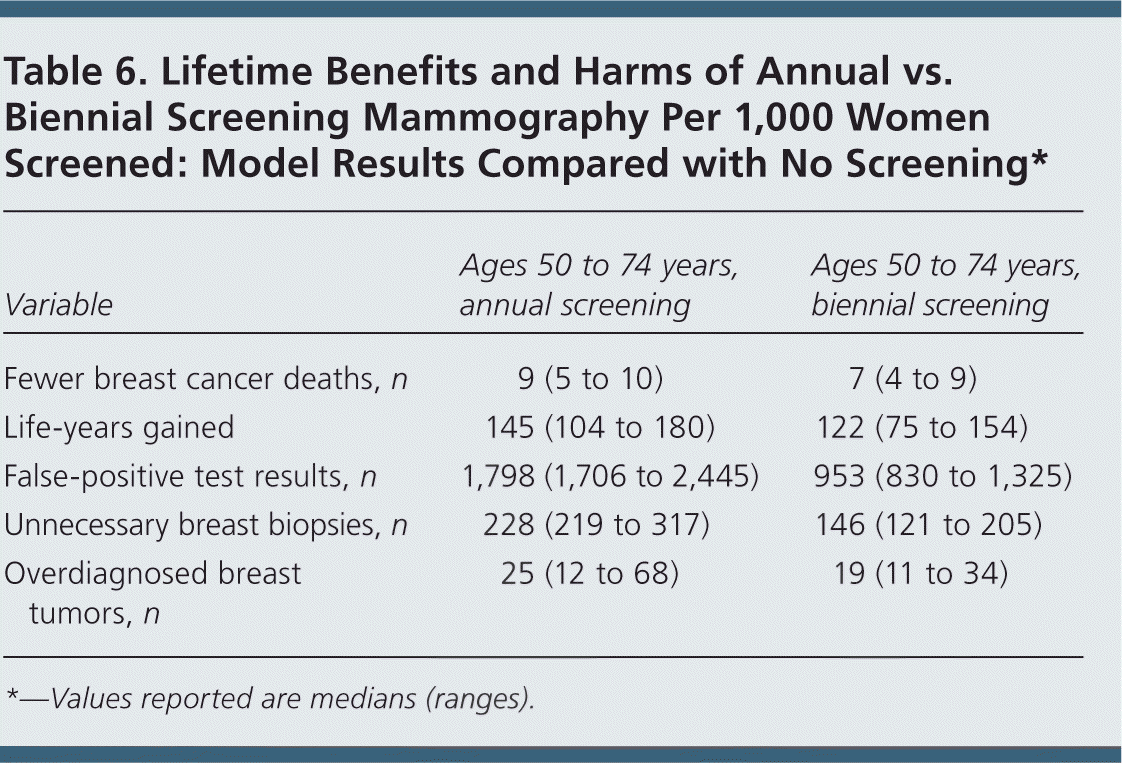
| Variable | Ages 50 to 74 years, annual screening | Ages 50 to 74 years, biennial screening |
|---|---|---|
| Fewer breast cancer deaths, n | 9 (5 to 10) | 7 (4 to 9) |
| Life-years gained | 145 (104 to 180) | 122 (75 to 154) |
| False-positive test results, n | 1,798 (1,706 to 2,445) | 953 (830 to 1,325) |
| Unnecessary breast biopsies, n | 228 (219 to 317) | 146 (121 to 205) |
| Overdiagnosed breast tumors, n | 25 (12 to 68) | 19 (11 to 34) |
WHEN TO CONSIDER STOPPING SCREENING
Clinical trial data for women aged 70 to 74 years are inconclusive. In its 2009 recommendation,11 the USPSTF extended the recommendation for screening mammography to age 74 years based on the extrapolation that much of the benefit seen in women aged 60 to 69 years should continue in this age range, and modeling done at the time supported this assumption. Current CISNET models suggest that women aged 70 to 74 years with moderate to severe comorbid conditions that negatively affect their life expectancy are unlikely to benefit from mammography.7,8,12 Moderate comorbid conditions include cardiovascular disease, paralysis, and diabetes. Severe comorbid conditions include (but are not limited to) AIDS, chronic obstructive pulmonary disease, liver disease, chronic renal failure, dementia, congestive heart failure, and combinations of moderate comorbid conditions, as well as myocardial infarction, ulcer, and rheumatologic disease.12
SCREENING IN WOMEN AGED 75 YEARS OR OLDER
The USPSTF found insufficient evidence to assess the balance of benefits and harms of screening mammography in women aged 75 years or older. CISNET models suggest that biennial mammography screening may potentially continue to offer a net benefit after age 74 years among women with no or low comorbidity,7,8 but no randomized trials of screening included women in this age group.2,3
DBT AS A PRIMARY SCREENING STRATEGY
The USPSTF found insufficient evidence to assess the balance of benefits and harms of DBT as a primary screening method for breast cancer.
Background. Evidence on DBT is limited; a single study on the test characteristics of DBT as a primary screening strategy for breast cancer met the inclusion criteria of the systematic evidence review.13
Potential Benefits. From the limited data available, DBT seems to reduce recall rates (that is, follow-up for additional imaging or testing) and increase cancer detection rates compared with conventional digital mammography alone.13 However, current study designs cannot determine whether all of the additional cases of cancer detected would have become clinically significant (that is, the degree of overdiagnosis) or whether there is an incremental clinical benefit to detecting these cancers earlier than with conventional digital mammography. In addition, no studies of DBT looked at clinical outcomes, such as breast cancer morbidity or mortality or quality of life.13
Potential Harms. As currently practiced in most settings, DBT exposes women to approximately twice the amount of radiation as conventional digital mammography.13 In 2013, the U.S. Food and Drug Administration approved a method to generate synthetic reconstruction of 2-dimensional images from 3-dimensional views, which reduces the total radiation dose associated with DBT. Although the extent to which this new software technology has been implemented in mammography screening centers is not precisely known, it is currently thought to be low. In women with abnormal findings, DBT may also increase the rate of breast biopsy compared with conventional digital mammography.13
PRIMARY AND ADJUNCTIVE SCREENING IN WOMEN WITH DENSE BREASTS
The USPSTF found insufficient evidence to assess the balance of benefits and harms of adjunctive screening for breast cancer using breast ultrasonography, MRI, DBT, or other methods in women identified to have dense breasts on an otherwise negative screening mammogram.
Epidemiology of Dense Breasts. In the United States, the most commonly used classification system for breast density is the American College of Radiology's Breast Imaging Reporting and Data System (BI-RADS) 4-category scale (a = the breasts are almost entirely fatty; b = there are scattered areas of fibroglandular density; c = the breasts are heterogeneously dense, which may obscure small masses; or d = the breasts are extremely dense, which lowers the sensitivity of mammography). Data from the BCSC indicate that about 25 million women (about 43%) aged 40 to 74 years are classified as having heterogeneously or extremely dense breasts. The proportion of women with dense breasts is highest among those aged 40 to 49 years and decreases with age.14
Increased breast density is a risk factor for breast cancer. Data from the BCSC indicate that, compared with women with average breast density, women aged 40 to 49 years with heterogeneously or extremely dense breasts have a relative risk (RR) of 1.23 for developing invasive breast cancer. For women aged 50 to 64 years with heterogeneously or extremely dense breasts, the RR is 1.29, and for women aged 65 to 74 years, it is 1.30.7 However, women with dense breasts who develop breast cancer do not have an increased risk for dying from the disease, after adjustment for stage, treatment, method of detection, and other risk factors, according to data from the BCSC.15
Primary Screening Test Performance Characteristics. Increased breast density reduces the sensitivity and specificity of mammography for detecting cancer. A BCSC study of more than 300,000 women found that sensitivity decreased from 87% in the lowest density category to 63% in the highest, and specificity decreased from 96% to 90% as breast density increased.16
A woman's BI-RADS breast density classification can be inconstant over time. Good-quality studies of U.S. radiologists demonstrate that major recategorization of sequential screening examinations (that is, from “dense” [c/d] to “nondense” [a/b] or vice versa) occurs in approximately 13% to 19% of women.17,18 These studies excluded women taking hormone medications or those with other medical conditions that may have resulted in physiologic changes that would explain the difference in breast density classification observed between examinations. Reclassification of breast density status from year to year complicates women's assessment of their underlying breast cancer risk, as well as informed screening and care decisions.
Primary Screening Frequency. In 1 BCSC study, biennial screening mammography was associated with greater risk for advanced-stage cancer (stage IIB or greater) (odds ratio, 2.39 [CI, 1.06 to 3.39]) or a breast tumor larger than 20 mm (odds ratio, 2.39 [CI, 1.37 to 3.18]) in women aged 40 to 49 years with extremely dense breasts (BI-RADS category d) compared with annual screening; this risk was not seen in women aged 50 to 74 years.19 No significant differences in lymph node involvement were observed in either age group. Information about morbidity or mortality end points is not available, so whether these women ultimately fared any differently in their clinical outcomes is not known.17,19
All women aged 40 to 74 years with increased breast density are at increased risk for a false-positive result, an unnecessary breast biopsy, or a false-negative result compared with women with average breast density. Screening more frequently (that is, annually vs. biennially) further increases the probability that a woman will experience one of these screening-related harms. Data from the BCSC indicate that the cumulative probability that a woman aged 40 to 49 years with extremely dense breasts screened annually for a decade will receive a false-positive result is about 69%, compared with about 21% for biennial screening. Similarly, unnecessary breast biopsy rates are 12% for annual screening versus 3% for biennial screening.17,18
Adjunctive Screening.
Potential Benefits. Current evidence on adjunctive screening is very limited, but it suggests that for women identified to have dense breasts on an otherwise negative mammogram, ultrasonography or MRI will detect additional breast cancer but will also result in a higher number of false-positive results. Data on DBT in women with dense breasts are limited, but in the short term, DBT also detects additional breast cancer. Most of the additional cancer detected by these methods are invasive tumors rather than ductal carcinoma in situ.17,18 A short-term increase in the number of cancer cases detected does not allow for the conclusion that adjunctive screening reduces treatment-related morbidity or breast cancer deaths or improves women's quality of life. Although adjunctive screening may detect more breast cancer, these cancers may fall into 1 of 3 categories: 1) those for which earlier detection leads to improved outcomes, 2) those that would have had the same outcome when detected later, or 3) those that are overdiagnosed and would not have caused a health problem during a woman's lifetime and may result in harms from unnecessary treatment. Existing data do not allow for estimation of the proportion of cancer that falls into each category; therefore, the benefits on health cannot be estimated.
Potential Harms. Most positive adjunctive breast cancer screening test results are false positive. Compared with mammography alone, adjunctive screening with ultrasonography or MRI seems to increase recall and biopsy rates. Data on the effects of DBT on recall and biopsy rates in women with dense breasts are too limited to draw conclusions.17,18 The effects of DBT on overdiagnosis rates are unknown.
Current Practice. At the present time, 24 states require patient notification of breast density status when mammography is performed; in some states, legislation also includes language to be sent to women informing them that they should consider adjunctive screening.17 No clinical practice guidelines explicitly recommend adjunctive screening in women identified to have dense breasts on an otherwise negative screening mammogram.17
Assessment. Increased breast density is very common. It is an independent risk factor for developing (but not dying of) breast cancer, and it reduces mammography's ability to find and accurately identify breast cancer. Many women will move between “dense” and “nondense” breast classifications with sequential screening mammograms, and these reclassifications are not primarily due to physiologic causes. More evidence is needed to better understand how the frequency of screening might affect important health outcomes in women with dense breasts. Overall, many important questions remain about the potential role of breast density in individualizing screening approaches, and the current evidence is insufficient to recommend a specific screening strategy for women with increased breast density.
OTHER APPROACHES TO PREVENTION
The USPSTF has made recommendations about the use of medications to reduce women's risk for breast cancer, as well as risk assessment, genetic counseling, and genetic testing for BRCA1- or BRCA2-related cancer (including breast cancer). These recommendations are available on the USPSTF Web site (http://www.uspreventiveservicestaskforce.org).
This recommendation statement was first published in Ann Intern Med. 2016;164(4):279–296.
The “Other Considerations” and “Discussion” sections of this recommendation statement are available at http://www.uspreventiveservicestaskforce.org/Page/Document/UpdateSummaryFinal/breast-cancer-screening1.
The USPSTF recommendations are independent of the U.S. government. They do not represent the views of the Agency for Healthcare Research and Quality, the U.S. Department of Health and Human Services, or the U.S. Public Health Service.
